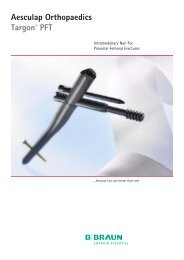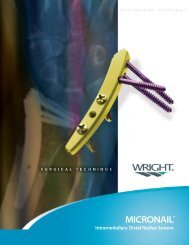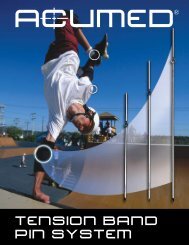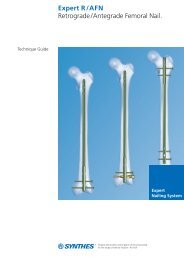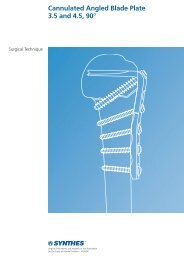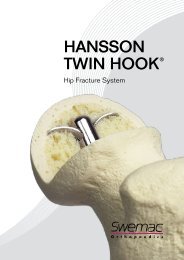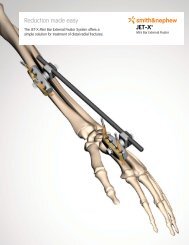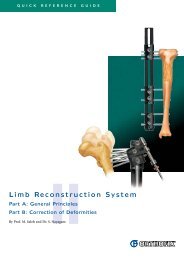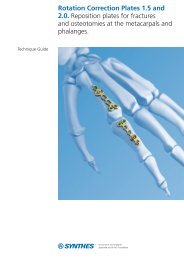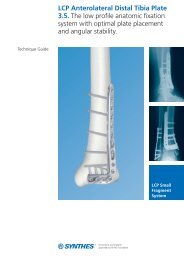HANSSON TWIN HOOK® - Osteosyntese
HANSSON TWIN HOOK® - Osteosyntese
HANSSON TWIN HOOK® - Osteosyntese
You also want an ePaper? Increase the reach of your titles
YUMPU automatically turns print PDFs into web optimized ePapers that Google loves.
<strong>HANSSON</strong><br />
<strong>TWIN</strong> HOOK ®<br />
Hip Fracture System
Hansson Twin Hook ®<br />
The Hansson Twin Hook is a new concept for<br />
the treatment of trochanteric hip fractures.<br />
Its development is based on the long and successful<br />
experience with the Hansson Pin System ® .<br />
The Hansson Twin Hook offers a STRONG, STABLE<br />
FIXATION with MINIMAL SURGICAL TRAUMA.<br />
Fig. 1. The Hansson Pin System has<br />
been used in more than 150 000<br />
femoral neck fractures until this date.<br />
The Hansson Twin Hook consists of two parts,<br />
an inner sliding tongue and an outer pin. The outer pin<br />
is 8.9 mm in diameter. Fixation in the femoral head is achieved by<br />
pushing the inner sliding tongue out through the proximal windows.<br />
The hooks are 4.6 mm in width and curls round and out about 11 mm<br />
on each side of the outer pin.<br />
The Hansson Twin Hook is used in combination with the Swemac<br />
Hip Plate or the Medoff Sliding Plate ® (Fig. 2 and 3).<br />
Fig 2. Swemac Hip Plate<br />
Each implant is individually sterile packaged for immediate use<br />
and greater inventory control. All implants are made from stainless<br />
steel 316 LVM.<br />
Hansson Twin Hook<br />
Patent no: 0101585-8<br />
Patent no: 0101585-<br />
Patent no: 0101585-8<br />
Fig 3. Medoff Sliding Plate
Olsson et al. Int. Orth. 2002<br />
Olsson et al. Int. Orth. 2002<br />
STRONG, STABLE Fixation<br />
High resistance against femoral head penetration<br />
9<br />
8<br />
Twin Hook<br />
Torque (N/m)<br />
7<br />
6<br />
5<br />
4<br />
3<br />
2<br />
1<br />
0<br />
Compression Hip Screw<br />
Fig 4. Simulation of impaired sliding between the plate/barrel and the Hansson Twin Hook.<br />
Loading and deformation tests using cadaver femoral heads have shown that the<br />
Hansson Twin Hook behaves different compared to the compression hip screw. In case of<br />
impaired sliding between the Twin Hook and the plate/barrel, the compressive forces are<br />
transmitted to the fixation of the Hansson Twin Hook in the femoral head rather than to<br />
the fracture (Fig. 4).<br />
If the compression screw moves, the bone is stripped. With the Hansson Twin Hook,<br />
instead of stripping the bone, the hooks will gradually bend, making this a more forgiving<br />
and durable fixation.<br />
Clockwise rotation 0-40° Counter clockwise rotation 0-40°<br />
1.8<br />
Load and deformation test<br />
Axial load (kN)<br />
1.6<br />
1.4<br />
1.2<br />
1<br />
0.8<br />
0.6<br />
0.4<br />
0.2<br />
Load-deformation graph in axial loading of a compression<br />
hip screw and a Hansson Twin Hook in two femoral<br />
heads with bone mineral density of 200 and 360 kg/m 3<br />
respectively, during 8 mm deformation.<br />
Twin Hook<br />
Compression Hip Screw<br />
0<br />
0 1 2 3 4 5 6 7 8<br />
Deformation (mm)<br />
The Hansson Twin Hook showed better resistance in cadaver femoral heads than the<br />
compression hip screw in the important area close to or in the subchondral bone.<br />
Note: The test was done with the first version of the Hansson Twin Hook. The outer pin<br />
was 8 mm in diameter and the width of the hooks were 3.8 mm. The frontal area of the<br />
current version of the Hansson Twin Hook is 25% larger than the one used in this test.
The frontal area of the Hansson Twin Hook is 30%<br />
larger than a compression hip screw.<br />
Load-deformation tests<br />
These radiographs were taken of the test<br />
specimens during load-deformation tests in axial<br />
loading of a compression hip screw and a Hansson<br />
Twin Hook in 160 kg/m 3 foam, during 8 mm<br />
deformation.<br />
Impaction of bone – maintained<br />
fixation<br />
The radiograph to the left shows the Hansson<br />
Twin Hook after being inserted in artificia foam<br />
material. The radiograph to the right shows the<br />
Hansson Twin Hook after being pushed<br />
forward 8 mm.<br />
The frontal area of the Hansson Twin Hook is 164.4 mm 2<br />
The Hansson Twin Hook maintains full<br />
torsional resistance after compression, making<br />
this a more forgiving and durable fixation than<br />
the compression hip screw.<br />
Stripping the bone – loss<br />
of fixation<br />
The radiograph to the left shows the compression<br />
hip screw after being inserted in artificial<br />
foam material. The radiograph to the right shows<br />
the compression hip screw after being pushed<br />
forward 8 mm. The compression screw is now<br />
loose and has in the radiograph been retracted<br />
to starting position without resistance.<br />
The frontal area of a Compression Hip Screw is 126.0 mm 2<br />
The compression hip screw lost fixation after<br />
1 mm of compression and cannot provide any<br />
torsional resistance anymore.
on et al. Int. Orth. 2002<br />
Olsson et al. Int. Orth. 2002<br />
High resistance against displacement<br />
Full contact<br />
Point contact<br />
Fig. 5. Hansson<br />
Twin Hook<br />
Fig. 4.<br />
Fig. 6. Compression<br />
Hip Screw<br />
Two hooks are positioned anterior and posterior with a total hook span of 31 mm.<br />
The hooks will be in contact with both cancellous and subchondral bone in the femoral<br />
head, providing a very good support against displacement.<br />
The Hansson Twin Hook will allow full bone and implant surface contact along the entire<br />
implant for better support against varus angulation (Fig. 5 and 6).<br />
Torsional test<br />
Torque (N/m)<br />
9<br />
8<br />
7<br />
6<br />
5<br />
4<br />
3<br />
Torque deformation graph in torsional loading<br />
of a compression hip screw and a Hansson<br />
Twin Hook in two femoral heads with bone<br />
mineral density of 260 and 310 kg/m 3<br />
respectively, during 40° clockwise<br />
and 40° counter-clockwise rotation.<br />
Twin Hook<br />
Compression Hip Screw<br />
2<br />
1<br />
0<br />
Clockwise rotation 0-40° Counter clockwise rotation 0-40°<br />
The Hansson Twin Hook gives 2-3 times better rotational resistance in cadaver femoral<br />
heads than a compression hip screw. Rotational stability of the Hansson Twin Hook in the<br />
1.8<br />
plate barrel is ensured through bilateral flattening of the shaft to match the inside of the hip<br />
1.6plate barrel.<br />
Axial load (kN)<br />
1.4Note: The test was done with the first version of the Hansson Twin Hook.<br />
The frontal area of the current version of the Hansson Twin Hook is 25% larger.<br />
1.2<br />
1<br />
0.8<br />
0.6<br />
Twin Hook
MINIMAL SURGICAL<br />
TRAUMA<br />
Unlike other devices, such as the standard compression hip screw system,<br />
the Hansson Twin Hook and operative procedure are both designed to<br />
minimize surgical trauma.<br />
No rotational forces during insertion<br />
The Swemac Hip Plate is inserted<br />
through a 50 mm skin incision.<br />
A. B.<br />
The plate/barrel is pushed into<br />
the pre-drilled hole in the lateral<br />
cortex.<br />
The smooth profile of the implant allows the Hansson Twin Hook to<br />
slide into place without twisting or hammering, thus minimizing the risk<br />
of displacement and greatly improving the chance of preserved femoral<br />
head vitality.<br />
Minimal operative exposure<br />
The complete procedure can be carried out through a 30-70 mm<br />
skin incision. A minimal operative exposure offers the following<br />
potential benefits:<br />
n Reduced bleeding<br />
C. D.<br />
n Less postoperative pain<br />
The Hansson Twin Hook and the<br />
introducer assembly are inserted<br />
through the plate/barrel and used<br />
as a joystick. When the Hansson<br />
Twin Hook have reached its final<br />
position, the introducer handle is<br />
turned clockwise as far as it<br />
will go.<br />
n Reduced need for blood<br />
transfusion<br />
n Shorter operating time<br />
n Reduced risk of infection<br />
n Early mobilisation<br />
n Early return to pre injury status<br />
n Cosmetic, patient satisfaction<br />
All cortical bone screws securing<br />
the plate to the shaft can be<br />
introduced through the same skin<br />
incision.
Minimal damage to cancellous bone<br />
62 mm 2 126.7 mm 2<br />
The damage to cancellous bone when using the Hansson Twin Hook is approximately<br />
50% less compared to a compression hip screw.<br />
Percutaneous removal procedure<br />
The Hansson Twin Hook can be removed through a 10 mm skin incision without need to<br />
remove the plate. The operation can be performed under local anaesthesia. Percutaneous<br />
removal can be advantageous in the case of a femoral head penetration, or if the patient<br />
suffers from soft tissue irritation after fracture healing, caused by the distal end of the<br />
Hansson Twin Hook protruding into the soft tissue.<br />
Fig. 7 Fig. 8<br />
The Hansson Twin Hook has penetrated the joint (Fig. 7). It was removed through a 10 mm<br />
skin incision under local anaesthesia and a new shorter implant was inserted. The fracture<br />
is stable due to previous impaction and healed successfully (Fig. 8).
Swemac Orthopaedics AB<br />
Industrigatan 11 • SE-582 77 Linköping • Sweden<br />
Hansson Twin Hook • 0206<br />
Phone +46 (0) 13 37 40 30 • Fax +46 (0) 13 14 00 26<br />
E-mail info@swemac.com



